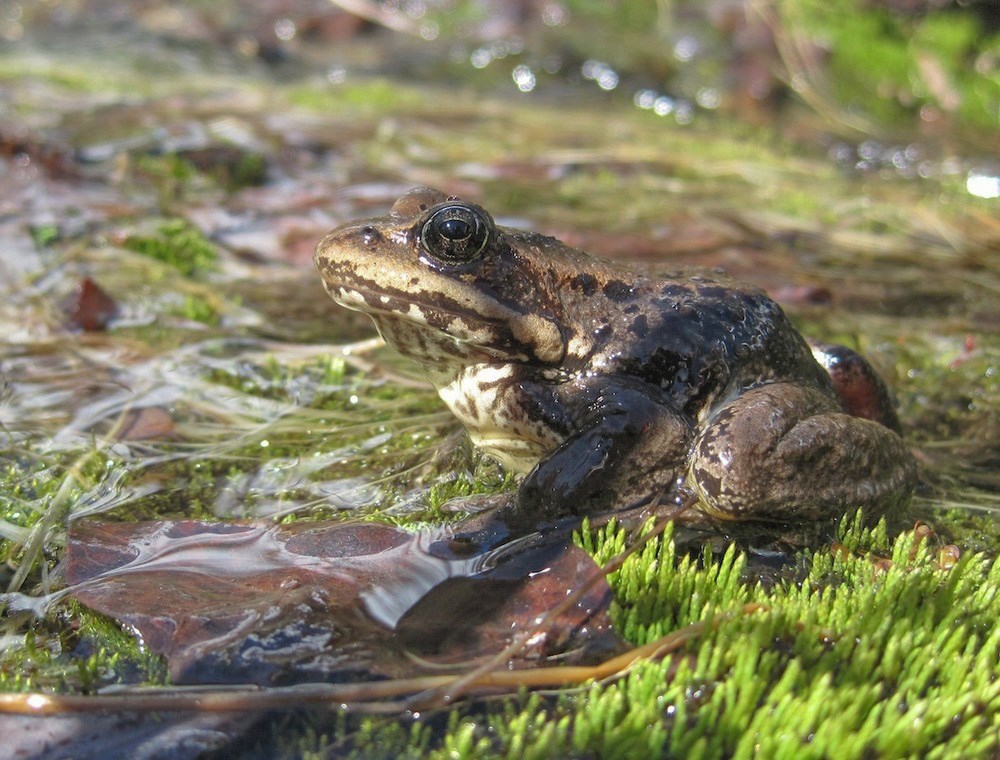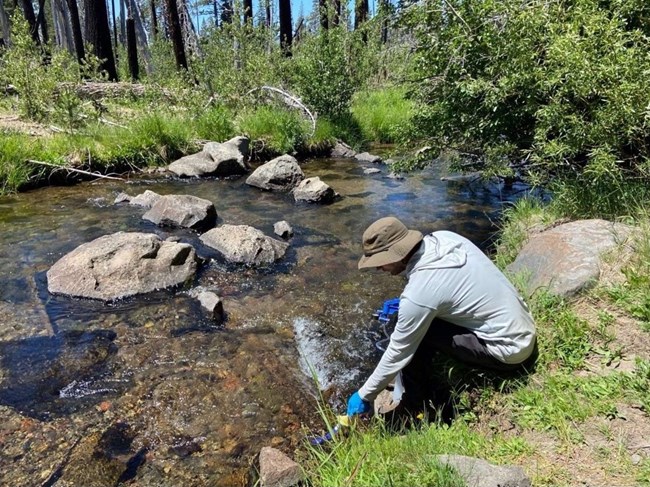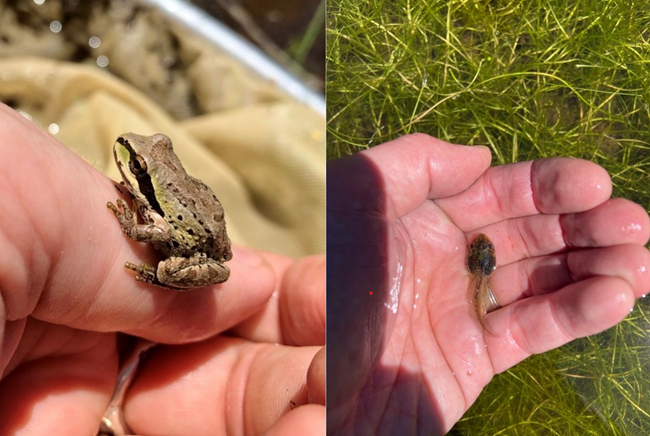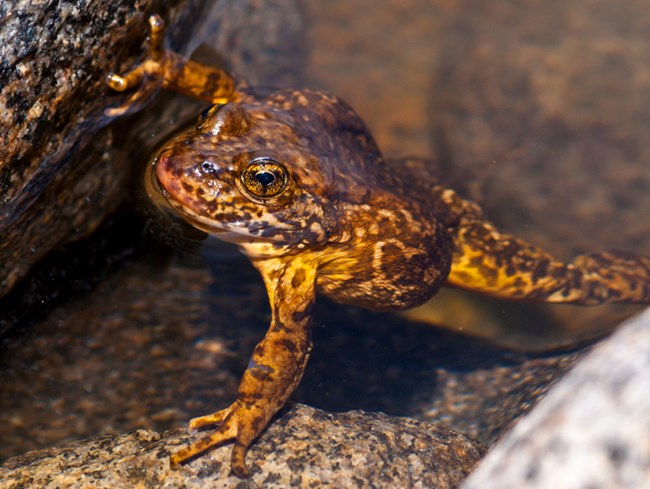Last updated: June 6, 2025
Article
Finding a Future for the Cascades Frog in Lassen Volcanic National Park
By Christina Martin, I&M Research Scientist and Communication Specialist
June 2025
For years, biologists suspected that the Cascades frog (Rana cascadae) had disappeared from Lassen Volcanic National Park (NP) in northern California. Once a common resident of mountain streams, ponds, lakes, and wet meadows, this small, brown-spotted amphibian seemed to vanish without a trace. Repeated surveys in the 1990s and early 2000s found fewer and fewer frogs. By 2011, none could be found.
But hope remained. Scientists asked: Could the frog still be hiding in parts of the park? And if not, could it come back?

NPS / S. Anderson
A Frog Facing Many Threats
The Cascades frog, like many amphibians, faces serious challenges. Natural predators like leeches and rainbow trout eat its eggs and tadpoles. The introduction of nonnative brook and brown trout to the park in the late 1800s made things worse. Previously stocked to support recreational fishing, trout quickly became a major predator of the frog in lakes and streams where fish had never lived before.
Disease emerged as another serious threat. Chytrid fungus, which has devastated amphibian populations worldwide, poses a deadly risk to the Cascades frog. Adding to these pressures, shifting climate conditions and other environmental disturbances have altered the high-elevation habitats the frogs depend on.
With disease impacts and fewer safe places to breed and grow, their numbers declined sharply over time.
A Thorough Search
In 2021, the National Park Service Inventory and Monitoring Program launched a study to find out if any Cascades frogs still lived in the park—and if not, whether they could return. To do this, scientists from WSP USA Environment & Infrastructure, Inc. combined traditional visual surveys with a powerful tool: environmental DNA, or eDNA.

NPS
With eDNA, researchers can detect tiny traces of genetic material that animals leave behind in their environment through waste, mucus, or other residues. By analyzing water samples, scientists can identify which species have been in the area, even if the animals themselves are not seen. This method is especially useful for hard-to-find species. If a frog is nearby, its DNA might be in the water, even if the frog isn’t seen.
Scientists surveyed 50 different spots across Lassen Volcanic NP, including ponds, lakes, and streams. They looked for frog egg masses, tadpoles, and adults. They also collected water samples to test for eDNA from frogs, trout, and leeches.

NPS
Sadly, no Cascades frogs, or their DNA, were found. But the news wasn’t all bad. At 18 sites, researchers found Pacific tree frogs (Pseudacris regilla), which also need clean, calm water to survive. That means those areas still support frogs. At 12 of those sites, there were no signs of trout, which is a good sign for possible Cascades frog reintroduction.
Building a Roadmap for Reintroduction
Finding frogs was just one of the project’s goals. The project also aimed to figure out where frogs could live in the future. Scientists created a "suitability model" by looking at factors like elevation, vegetation, water sources, and climate data. Cascades frogs prefer cool mountain areas with still or slow-moving water for breeding. Wetland plants provide cover and places to lay eggs, while nearby grasses and shrubs help keep the ground moist, which is vital for their survival during dry periods.
Some of the surveyed sites matched these ideal conditions, but post-survey wildfire damage has made them less hospitable in the short term. As vegetation recovers, these areas should once again be ideal for supporting amphibian life. And looking ahead, climate models suggest that conditions within the park may become more favorable for the Cascades frog, even as areas around the park become less suitable.

© Isaac Chellman
To guide next steps, scientists can look to other successful amphibian reintroductions in California. The Sierra Nevada yellow-legged frog (Rana sierrae), a close relative of the Cascades frog, faces similar threats such as chytrid fungus, habitat changes, and the introduction of nonnative predators. Over the last couple decades, wildlife agencies collaborated to bring this species back in places like Sequoia and Kings Canyon National Parks. Their efforts included removing nonnative fish, releasing frogs raised in captivity, and treating some frogs to help them survive disease.
Although progress has taken time, many reintroduced yellow-legged frogs are now surviving and breeding in the wild. These efforts show that recovery is possible. They also show that it requires careful planning, long-term commitment, and strong collaboration. Similar steps, including improving habitat, managing disease, and closely monitoring reintroduced frogs, will likely be needed to bring the Cascades frog back to Lassen Volcanic NP.
Hope for the Future
While recovery will take time and careful planning, this study has already taken an important first step. It identified the best places in the park for potential reintroduction and showed which areas may need active management, such as removing fish or restoring vegetation to improve habitat.
This research opens the door for the Cascades frog to one day return to Lassen Volcanic NP. With the right conditions and thoughtful action, this native frog might once again leap through the park’s mountain meadows and chorus in quiet waters.
Tags
- lassen volcanic national park
- inventory
- inventories
- species inventory
- inventory and assessment
- inventory and monitoring division
- natural resource stewardship and science
- california
- biodiversity
- frogs
- resource management
- natural resource management
- collaborative conservation
- klamath network
- klmn
- edna
- habitat restoration
